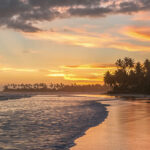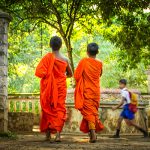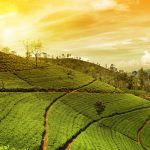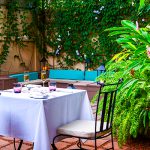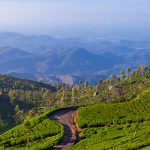Joy, despair and relief in Sri Lanka’s north east
If ever there was a tour that ran the whole gamut of emotion, joy, excitement, fear, despair, relief, humour my recent trip to the North and East would be it. It all began when three of my friends – Thilina, Anoma and Thushari – decided to tour the North and East and invited me along. I was ecstatic as the North and East was unexplored Sri Lanka to me (that was before they appointed me to handle the accommodation for a five night tour and plan the trip on a budget that’s too embarrassing to be mentioned here).
Usually I would have spent hours on research and planning out such a tour, but not this time around. Being a relatively new recruit to the Red Dot sales team, I was more involved in planning the summer holidays of my clients. However, our plan was for five nights. Leave evening of 5 May go to Anuradhapura start early for Jaffna next morning en route visit Madu Church spend two nights in Jaffna and one night in Trincomalee followed by one night in Habarana to relax. Given the unrealistic budget that I was given to work with, I realised from the onset that the best way to go forward was to pull favours and find free accommodation. With the help of family and friends we were able to find accommodation for two nights in Kankasanthurai Camp as well and one night at the Air Force Camp China Bay in Trincomalee. So there was only one night in Habarana which I left open to find accommodation when we got there.
The first setback came on the 5th evening when we realized that we were too tired to start on the tour after a hard day’s work. So we set off at 4am next morning for Jaffna. We made good time and reached Medawachchiya around mid afternoon and took the A14 the route to Mannar which also led to Madu Church. The road was reasonably good and more road work was underway. The sight of the now almost desolate Manik Farm on the A14 road brought to mind what hardship the 160,000 or so Tamil Refugees housed there would have undergone living in the small huts or tents made of aluminum sheets or wooden planks with inadequate sanitary conditions.
The rebuilt church at Madu Road is a very important pilgrim site for Catholics in Sri Lanka. The Madu Church alter houses the Our Lady of Madu Statue that was brought there in 1670 by 20 catholic families fleeing prosecution by the Dutch at Mantai near Mannar. The church is renowned for its miraculous powers and the Madu festivals attracts millions of devotees. The church was deserted on this weekday and after paying our respects we were back on the A 30 which led to Vavuniya. The A 30 was in better condition and more road work was underway. We reached Vavuniya town around 3pm and fell on to the A9 to drive to Jaffna. We reached Omanthai and passed through the security check point with ease.
We passed Kilinochchi which was then the capital of Tamil Elam and Elephant Pass in which the Sri Lankan army faced one of its greatest defeats. We also passed villages such as Pulliynkulam, Mankulam, Kokkavil, Kodikamam, towns that were hitherto only names on the map. Except for the small hamlets that we passed vast areas along the A9 were completely uninhibited yet. As we neared Jaffna the Palmyra trees become a dominant feature and boundary walls constructed from dried Palmyra fronds become common place. It was around 7pm when we reached Jaffna Town and fell in to Kankasanthurai Road to get to the KKS camp. As soon as we reached the accommodation arranged for us we had a quick dinner and were soon all out for the count.
The next morning was instrumental in changing the course of our trip by unknown proportions. I was woken up by the ringing of my mobile phone and my sisters distressed voice saying that my mum was really sick. I think I stopped listening after the words heart failure and felt my whole world crashing down. What I think she said was that my mum’s ECG report was really bad according to a doctor! My only thought was of reaching Colombo as soon as possible. At that instance I felt like I was in another continent for all the time it would take me to reach Colombo.
Within a few short minutes Shehan a good friend from the aviation field arranged for me to fly to Colombo by Heli tours. I requested my friends to drop me at the Heli tours office in Jaffna and to continue on to visit Nagadeepa as planned. They reluctantly agreed. The Heli tours officers were extremely helpful and courteous and within minutes I had paid and was issued with a one way ticket to Colombo. I was instructed to be back there at 12 noon to be transferred to Palali airport. Since I had one hour I decided to do some sightseeing by tuk-tuk and did a quick tour to see the Jaffna Fort and the Jaffna Library
which was torched down in 1981 and subsequently rebuilt. Jaffna town is a thriving town and does not bear the ravages of the long civil war that tore the country apart. The heavy military presence in the town does not deter from its charms. By 11.45 am I was back at the Heli tours office and about to board the bus to Palali when my sister called to say my mum was OK and it was a false alarm. The relief and happiness I felt knew no bounds. I still wanted to get back to Colombo as planned, but my sister insisted there was no need. The ever-courteous Heli tours officers refunded the money for my ticket and I left the office to await my friends.
Well, wait I did for a good three hours (at the Civil Affairs & Public Relations office opportunely situated directly opposite Heli tours office), as Thilina had lost the car keys at Nagadeepa Kovil! The Corporal that was assigned to take my friends on sightseeing was coming to Jaffna in order to take a locksmith to cut new keys for the car. So with a corporal and a locksmith as my travelling companions, I undertook an amazing journey by tuk-tuk from Jaffna to Punkuduthivu. From Jaffna a long causeway led to Kayts from there another causeway led us to Punkuduthivu where my friends were stranded. When you travel by car you are an observer and there is always a sense of watching the world through a glass. But not so in a tuk-tuk. With the wind whipping the hair and the sights, sounds and smells of the surroundings I felt that I was experiencing the real north of this beautiful Island. After the car was fixed we came back to Jaffna around 7pm and walked in the town to buy some provisions. Then it was to an Ice cream Parlor to sample the famous Jaffna Ice Cream. The scrupulously clean and well lit Ice Cream Parlor served us within five minutes of placing our order. Our second night in Jaffna thus ended on that sweet note.
On the third day we were back on to our planned itinerary albeit a few sights behind schedule. We bid our Army friends good bye and was on our way eager to regain on the lost time. Our first stop was Dambakolapatuna port in Jaffna where Sangamiththa Theri alighted bearing the right branch of the Bo tree that helped Lord Buddha attain Nirvana. The next stop was the Keerimalai Pond which is a natural spring lying next to the sea west of Palaly. The beautiful fresh water pond with its stone walls and turquoise water is well worth a visit. According to folklore an Indian priest with a mongoose face bathed in this pond and his face turned in to human form . It’s also said a Pandiyan Princess with a horse shape head was cured after bathing in this pond. We were told by our friends of the current belief that if one bathes in this pond one becomes beautiful . We certainly did not want to miss an opportunity to turn in to swans so ended up bathing in this pond. The pond is divided into male and female areas and the surrounding is relatively clean. But if one is to have a leisurely swim the best time to visit would be the early morning before bus loads of visitors arrive for bathing.
From Keerimalai with a brief stop at the Nallur Kandasamy Kovil we headed to Point Pedro (PPD) which is the most northerly point in Sri Lanka. There is a lighthouse, a fishing harbor and a number of churches around PPD. I found the journey to Point Pedro quite tedious and would have been happier if we had forgone this detour in order to keep to our itinerary of getting to Trincomalee by early evening.
The Sri Lanka road map we were using was an excellent tool for novice travellers like us and studying it we realized that if we took the A29 from Vavuniya to Horowpatana we would get to Trincomalee much faster. We called our air force friend in China Bay who advised us not to come by that road due to its bad condition. But by the time we came to Vavuniya it was nearly 6 pm. We were tired and the A 29 beckoned us. In addition the Police officer who was stationed at the junction blithely said that the road (A29) was good for travelling. We took his word and set off on the A 29 with great hope of getting to Trincomalee within a couple of hours. All was well for the first few kilometers and there were a few houses, and we did see people intermittently. The deeper we went all signs of habitation lessened and we barely saw a human being. It was pitch dark and the road did not boast a single street light. To make matters worse, the condition of the road was at its worst. In some stretches there were huge mounds of earth stacked up on the road. Our fear was palpable and the grave silence inside the car was testimony to it. There was no way that we could turn back. So we continued onwards. We came to Kebithogollawa which is a little town and felt better as there were lights and shops and people around. Just as soon as we passed the town things did become bad again. Another twenty odd kilometers of the same road conditions followed and by the time we arrived at Horowpathana we were thankful that we were safe and that the car was in running condition. I could safely say that it was the most scary and foolhardy journey that I have ever undertaken in my life.
It was 10 pm when we reached Trincomalee Town and another one of our friends ( Shehan) had decided to join us for the last couple of days of the tour. Since he had not received security clearance to stay at China Bay Camp we all decided to stay at Oshine Guest House in Trincomalee. Although not ideal, we were happy that it was clean at least.
After a hearty breakfast next morning we set out to do some serious sightseeing. The first was the Fort Frederick which was built by the Portuguese followed by Koneshwaran temple which is a Hindu temple visited by Hindu devotees and other visitors to Trincomalee, who makes it a must to visit this Kovil built on the high cliffs above the sea. Behind the temple is the Lovers Leap where it’s said that a Dutch Cornels daughter leapt to the sea following the departure of her lover. The views from Koneshwaran temple are magnificent.The next stop was the Nilaveli beach which is 16 Km off Trincomalee. Nilaveli is Sri Lanka longest beach and is a popular swimming place due to it being a safe swimming area. It was an experience to change in to our swimming gear inside the car and go for a swim in the calm blue waters of the sea. It was truly memorable to then come back and pay Rs 20 to bath in the tanks filed up with water. This endeavor provided some hilarious photo opportunities for us.
Trincomalee has the ear marks of being one of the best tourist destinations in Sri Lanka. The recent opening of the up market Chaaya Blue and the Nilaveli Beach Hotel which is already a firm favorite would see many more tourist visiting Trincomalee in the near future. The little guesthouses, such as the Palm Beach in Uppuveli, means that Trincomalee is within anyone’s budget.
Our next stop was the Hot Wells in Kanniyai, about 7 Km off Trincomalee town. There are seven hot wells with varying water temperatures from cool to very hot and its believed that these waters contain therapeutic powers. A few of my friends were brave enough to wrestle with the immense crowd to obtain a bucket and bath in all the seven wells. I made do with washing my face in all of the seven wells which I thought was the next best thing to do. I did not find the change rooms or the surrounding area clean and would find it hard put to recommend bathing there.
We were also all eager to visit the Kinniya bridge known as Sri Lanka’s longest bridge. Kinniya which is a small fishing village in the North Eastern cost of Sri Lanka is separated by a lagoon from Trincomalee. The villagers in Kinniya had to use the ferry service to commute as well as to ferry their daily needs, house hold equipment and other miscellaneous goods. With the opening of the 396 meter Kinniya bridge new life has been breathed in to the people of Kinniya. The ferry that was operating from morning till 10 pm now lies abandoned by the side of the jetty. The new bridge with its 7.4 meters width lane for vehicles and 1.5 meter walkway for pedestrians is a sight to behold.
With all the sightseeing behind us it was now time to relax. We came to Habarana and found a quaint little guesthouse and had a relaxing evening for the first time while on tour followed by a wonderful night.
The next morning after a refreshing cup of hot tea we checked out of the guesthouse and had a great breakfast from a little dive on the way. The food tasted good and it was clean as could be expected from a way side dive. Our destination was Sigiriya Rock Fortress where Thilina and Ano climbed the rock while Thushari, Shehan and me stayed at the foot having a wonderful chat. ( We had climbed it too many times and was too tired to attempt it on this Monday morning) By mid morning the adventurous pair had returned and we made a leisurely journey back to Colombo.
There is much to learn from travelling and the experience gained through such travels makes it possible to plan for better tours. Arduous travelling such as the five day tour that we undertook is not for everyone. But a more relaxed tour to sample the charms of the North and East could definitely be recommended to anyone.
